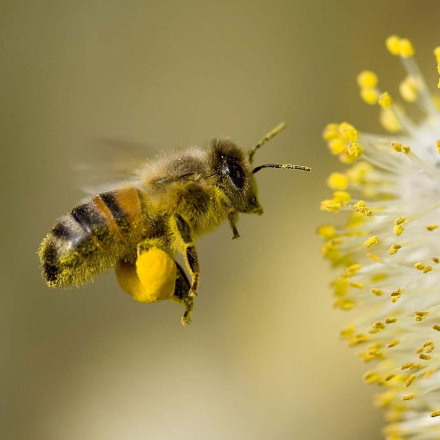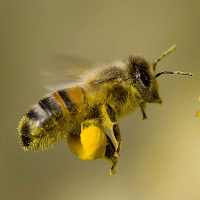
HONEY BEES
Identification, Facts, & Control
Latin Name
Apis (all Apis)
Appearance
 1/2" to 1 inch long, brown, black, and orange sometime yellow with an oval-shaped body
1/2" to 1 inch long, brown, black, and orange sometime yellow with an oval-shaped body
Description and Habits
There are three castes of honeybees in the colony: (1) the one-per-coiony long slender queen (2) the few stout robust male drones, and (3) the thousands of workers.
The queen is responsible for reproduction. The drone's only purpose is to mate with one virgin queen one time, while lfying outside the hive, after which he immediately falls to the ground and dies. The drones which do not die this way are killed or forced out of the hive as the nectar supply gets smaller in the fall of the year.
The workers, which may number 20,000 to 60,000 per hive do all the other work: feeding the queen; keeping the hive clean; fighting off ants or robber bees from other hives; making the beeswax comb in which the young are developed and in which the pollen and nectar are stored; caring for the young larvae in the comb; and going out and finding and collecting the pollen and nectar.
Honey is essentially evaporated and aged nectar. Pollen, or "bee bread", is the main food of the young bees. Workers live about three months (less in the heavy honey flow season when their wings and bodies wear out from all the work). Those that emerge from the pupal stage in the fall overwinter in the adult stage. They remain relatively dormant in the colder parts of the country, or sometimes the whole colony freezes to death. Stored honey is their food during the winter.
When the bee stings, she inserts a stinger that has barbs on two sides. This prevents her from removing the stinger once it is inserted into the victim. In her frenzied attempt to pull away, the shaft of the stinger, a poison sac, and a self acting muscle are ripped from her body, and she dies within a few minutes. But the self acting muscle continues to work, forcing the stinger and poison deeper into the victim even after the bee is gone. When a person is stung, they should never grasp the stinger (What are most visible are the muscle and the poison sac.) and pull it out. This squeezes the poison from the poison sac into the flesh, increasing the pain. The stinger should be scraped out with the finger nail. It's better to leave the shaft of the stinger in the flesh than to squeeze the poison sac.
Only the worker bee stings people. The drones have no stinger and cannot sting. The queens have a very proficient stinger that can be used many times killing other queens. But they will not sting humans.
Biology and Life Cycle
The queen honeybee is a remarkable egg-laying machine. At her peak production she may lay more than her own weight in eggs in one day on a continuous basis. As in most complete metamorphoses, the stages of development are: egg, larva, pupa, and adult. The young adult workers care for the eggs and larvae, which are located in the cells in the comb in an area called the "brood chamber".
The older adults go out in search of nectar. When they return, they communicate where the nectar is located, and how far away it is. This is done by a "wag tail dance" that they perform on the comb for the other bees to see.
When the colony becomes large enough for a new colony to be formed, the workers begin feeding a few very young larvae a substance called "royal jelly". This substance causes the young larvae to develop into queen bees in a greatly enlarged cell, instead of merely becoming workers. The old queen attempts to destroy these new larger cells, but they are protected by the workers.
The old queen then leaves the hive with a few thousand workers in the form of a "swarm" and seeks a new location (and the owner of the new location then becomes a customer of a PCO).
Meanwhile, back in the hive, the first new virgin queen to emerge from the pupa stage attempts to destroy all the other queen cells. Usually she is not completely successful and two or more virgin queens are loose in the hive at the same time. But not for long! They fight to the death until only one remains. after about five days the virgin queen goes on her mating flight.
Mating takes place only in the air. This process results in fatal injury to the successful drone. He falls to the ground dead.
The swarm accompanying the old queen flies until she tires, coming to rest on a tree limb, fence post, bush, or similar place. But if this location is not suitable for establishing a new colony, scout bees will seek out a more suitable site. Upon their return, the swarm will follow the scout bee that pefrorms the most enthusiastic "dance". Openings in sidings, and entrances into attics or wall voids, or chimneys, are some favorite locations.
Notes on Control
- A swarm on a tree or shrub probably will leave of its own accord within a day or two. The local State extension service entomologist usually can furnish the name and phone number of a local beekeeper interested in this easy to capture type of swarm. Or, an insecticidal treatment with a power sprayer will probably eliminate the swarm.
- New swarms are easier to control than swarms that have built comb and established a brood chamber with both adult bees and sealed brood between the combs.
- After applying a pesticide, the dead bees sometimes leave an undesirable odor. Removing dead bees,the wax combs, and the honey reduces the likelihood of re-infestation by other bees, dermestids, and wax moths. If this is impossible, which usually is the case, at lease all entrance holes should be plugged.
- If an entrenched infestation is in a wall on the hot sun side of a structure, and the bees are killed, sometimes the comb will be melted and honey will run out. A colony of (live) bees creates its own ventilation system which often keeps this from happening.
- Bees can be trapped out of wall voids by the use of a wire cone about 18" long and a bee hive, but this requires several weeks.
- Insecticide dust usually can be blown into the nest inside a wall by drilling a hole if the colony can be precisely located in the wall. Treating at night reduces the likelihood of being stung.
- Voids in exterior walls are a good spot to check when suspecting a colony of bees.
Click on a species of bees below to learn further information.
Having trouble with Pests?
Give us a call: 661-645-6855
Or have Traffic contact you today and get a FREE estimate for:
Your Neighborhood Bug Guys!
Traffic Pest Solutions (LA)
15828 Toscana Ct.
Santa Clarita, CA 91387
Phone: (661) 645-6855Santa Clarita, CA 91387

 Honey Bees
Honey Bees Carpenter Bees
Carpenter Bees Bumble Bees
Bumble Bees Sweat Bees
Sweat Bees